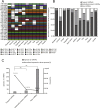Identification of exosome-like nanoparticle-derived microRNAs from 11 edible fruits and vegetables
- PMID: 30083436
- PMCID: PMC6074755
- DOI: 10.7717/peerj.5186
Identification of exosome-like nanoparticle-derived microRNAs from 11 edible fruits and vegetables
Abstract
Edible plant-derived exosome-like nanoparticles (EPDELNs) are novel naturally occurring plant ultrastructures that are structurally similar to exosomes. Many EPDELNs have anti-inflammatory properties. MicroRNAs (miRNAs) play a critical role in mediating physiological and pathological processes in animals and plants. Although miRNAs can be selectively encapsulated in extracellular vesicles, little is known about their expression and function in EPDELNs. In this study, we isolated nanovesicles from 11 edible fruits and vegetables and subjected the corresponding EPDELN small RNA libraries to Illumina sequencing. We identified a total of 418 miRNAs-32 to 127 per species-from the 11 EPDELN samples. Target prediction and functional analyses revealed that highly expressed miRNAs were closely associated with the inflammatory response and cancer-related pathways. The 418 miRNAs could be divided into three classes according to their EPDELN distributions: 26 "frequent" miRNAs (FMs), 39 "moderately present" miRNAs (MPMs), and 353 "rare" miRNAs (RMs). FMs were represented by fewer miRNA species than RMs but had a significantly higher cumulative expression level. Taken together, our in vitro results indicate that miRNAs in EPDELNs have the potential to regulate human mRNA.
Keywords: Cross-kingdom; Exosome-like nanoparticles; Illumina sequencing; miRNA expression profile; miRNAs expression profile.
Conflict of interest statement
The authors declare there are no competing interests.
Figures




References
-
- Araceli C, Madelourdes PH, Maelena P, Joséa R, Carlosandrés G. Chemical studies of anthocyanins: a review. Food Chemistry. 2009;113:859–871. doi: 10.1016/j.foodchem.2008.09.001. - DOI
LinkOut - more resources
Full Text Sources
Other Literature Sources
Miscellaneous

